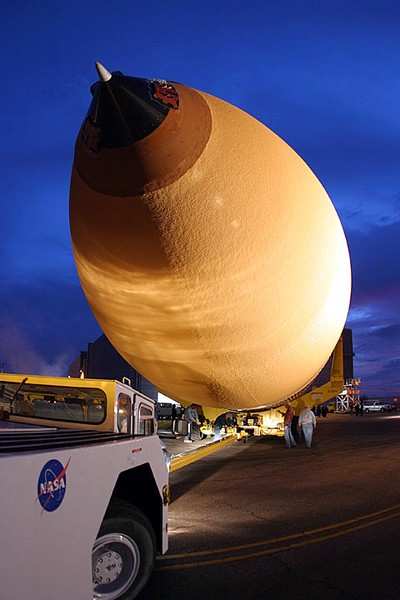Testing Now Underway; Gouge Penetrated Tiles
Spacewalkers Dave Williams and Rick Mastracchio removed a faulty
attitude control device on the International Space Station Monday,
during their second spacewalk in three days... but most of the
world's attention is focused on launch damage to the shuttle
Endeavour, which may be worse than first believed.

Scans taken of the orbiter's underside Sunday show a
3.5-inch-long gouge in two adjoining thermal tiles near Endeavour's
right maingear door. Some of the damage penetrates the tiles'
one-inch thickness, down to the orbiter's aluminum skin -- meaning
a spacewalk to attempt to repair the damage might be necessary.
Fortunately, NASA says, astronauts have trained extensively for
such a repair, in the wake of the 2003 reentry loss of
Columbia.
"This is something we would rather not deal with, but we have
really prepared for exactly this case," John Shannon, the chair of
NASA's mission management team, told The Associated Press. "I feel
very comfortable that whatever is required, we can go do and do
successfully."
Shannon added the shuttle Discovery suffered even more damage in
the same location as Endeavour during a l998 mission -- and landed
safely.
Engineers are now conducting computer-based thermal analyses, to
determine if Endeavour can withstand reentry will the damage. They
are also testing samples of tiles with identical damage under
simulated reentry conditions. Those results should be available by
Tuesday at the latest, Shannon said.

Should a spacewalk be necessary, two astronauts would secure
themselves to Endeavour's robotic arm using a special 100-foot-long
extension. Crewmembers onboard the shuttle would then maneuver
their fellow STS-118 astronauts under the wing to effect
repairs.
The nature of those repairs will depend on the results of NASA's
testing. Possible repair methods include covering the gouge with a
screw-on panel, dabbing a dark silica-based undercoating over the
damage, or pumping a thicker caulk-like substance, also composed of
silica and carbon, into the opening and smoothing it down.
Will This Mean More Delays For Shuttle Program?
Meanwhile, NASA has narrowed the likely cause of the damage to a
baseball-sized chunk of insulating foam, that sheared off a bracket
connecting a propellant line to the shuttle's external fuel tank 58
seconds into the flight.

Images taken during launch show the foam striking a strut
connecting Endeavour to the tank at a velocity of 200 mph. The
impact deflected the foam onto the underside of the orbiter's right
wing.
A similar incident -- in which a chunk of foam hit the leading
edge of Columbia's left wing during its January 2003 launch -- led
to the reentry loss of that orbiter, as hot gasses caused by
reentry were able to breach the shuttle's heat shield through the
resulting damage.
Program managers were already planning to phase in titanium
fittings, to replace the foam-covered brackets, on future missions.
The new design would fix a flaw in the current bracket system,
which allows the propellant line to move during launch -- causing
the ice-coated line to grind against the tank's foam
insulation.
However, three more missions are scheduled to fly with the
current tank design -- but after this latest incident, NASA may opt
to hold future missions until the new design is ready to fly,
adding at least six months to the current schedule of shuttle
flights ahead of the planned 2010 retirement of the fleet.
"We have a lot of discussion to have before we decide to fly the
next tank," Shannon said. The next mission is scheduled to fly in
October.
 Airborne 04.16.24: RV Update, Affordable Flying Expo, Diamond Lil
Airborne 04.16.24: RV Update, Affordable Flying Expo, Diamond Lil ANN's Daily Aero-Term (04.20.24): Light Gun
ANN's Daily Aero-Term (04.20.24): Light Gun Aero-News: Quote of the Day (04.20.24)
Aero-News: Quote of the Day (04.20.24) Aero-News: Quote of the Day (04.21.24)
Aero-News: Quote of the Day (04.21.24) ANN's Daily Aero-Term (04.21.24): Aircraft Conflict
ANN's Daily Aero-Term (04.21.24): Aircraft Conflict





